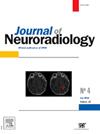Experimental study on the mechanism of cerebral edema development and MM-MRI manifestation in burned rats
IF 3
3区 医学
Q2 CLINICAL NEUROLOGY
引用次数: 0
Abstract
Objective: The goal of this study was to investigate post-burn cerebral edema, establish its MM-MRI manifestation, and explore the underlying molecular mechanisms. Methods: Rats were randomly assigned to four groups (8h, 24h, 48h, and 72h post-burn) and subjected to thermal burns to induce skin injury, following the rat burn model. Treatment was administered based on Parkland's formula. At specific time points, rats were evaluated using MM-MRI sequences (T1 WI, T2 WI, T2 FLAIR, DWI, and ADC mapping) alongside histological analysis (H&E, TEM) and molecular techniques (IHC, IF, and WB). Results: All experimental groups exhibited significantly increased post-burn cerebral edema compared to the sham control group. While no significant changes were observed on T1WI, T2 WI, and T2 FLAIR images, post-burn cerebral edema was clearly visible on DWI and ADC maps in the region of interest (ROI) the basal ganglia. Histological analysis (H&E, TEM) corroborated these findings. Notably, all experimental groups (8h, 24h, 48h, and 72h) showed upregulated expression of AQP4 compared to controls, as evidenced by IHC, IF, and WB. Further, astrocyte end-feet and endothelial cells exhibited significant swelling may be due to AQP4 overexpression, leading to increased intracellular water content. Conclusion: This study confirms the presence of post-burn cerebral edema in the early stages following burn trauma, might be mediated by AQP4, as supported by histological findings. Radiological results indicate that DWI and ADC mapping are sensitive methods for diagnosing and monitoring post-burn cerebral edema.
烧伤大鼠脑水肿发生机制及MM-MRI表现的实验研究。
目的:研究烧伤后脑水肿,建立其MM-MRI表现,并探讨其分子机制。方法:按照大鼠烧伤模型,将大鼠随机分为4组(烧伤后8h、24h、48h、72h),进行热烧伤诱导皮肤损伤。治疗是根据帕克兰的公式进行的。在特定时间点,采用MM-MRI序列(T1 WI, T2 WI, T2 FLAIR, DWI和ADC作图)以及组织学分析(H&E, TEM)和分子技术(IHC, IF和WB)对大鼠进行评估。结果:各实验组与假对照组相比,烧伤后脑水肿明显增加。虽然T1WI、T2 WI和T2 FLAIR图像未见明显变化,但DWI和ADC图在基底节区感兴趣区(ROI)清晰可见烧伤后脑水肿。组织学分析(H&E, TEM)证实了这些发现。值得注意的是,所有实验组(8h、24h、48h和72h) AQP4的表达均较对照组上调,IHC、IF和WB均证实了这一点。此外,星形胶质细胞端足和内皮细胞表现出明显的肿胀,可能是由于AQP4过表达,导致细胞内含水量增加。结论:本研究证实了AQP4在烧伤早期出现烧伤后脑水肿的机制,并得到了组织学结果的支持。影像学结果表明,DWI和ADC成像是诊断和监测烧伤后脑水肿的灵敏方法。
本文章由计算机程序翻译,如有差异,请以英文原文为准。
求助全文
约1分钟内获得全文
求助全文
来源期刊

Journal of Neuroradiology
医学-核医学
CiteScore
6.10
自引率
5.70%
发文量
142
审稿时长
6-12 weeks
期刊介绍:
The Journal of Neuroradiology is a peer-reviewed journal, publishing worldwide clinical and basic research in the field of diagnostic and Interventional neuroradiology, translational and molecular neuroimaging, and artificial intelligence in neuroradiology.
The Journal of Neuroradiology considers for publication articles, reviews, technical notes and letters to the editors (correspondence section), provided that the methodology and scientific content are of high quality, and that the results will have substantial clinical impact and/or physiological importance.
 求助内容:
求助内容: 应助结果提醒方式:
应助结果提醒方式:


